I was raised in a devout Southern Baptist household in rural Texas. My family’s belief system was the firm, unwavering foundation of our home; every aspect of daily life was rooted in our faith. As a child, I was unusually tuned in to the suffering of those in bible stories--the violence, emotional trauma, and physical pain people endured. As I matured, I began to keenly observe and internalize the suffering of those around me, particularly those within my church. I was profoundly interested in how people processed and survived trauma and grief, and how gracefully they endured emotional pain. Even now, I tend to bury myself in the suffering of others; I am often empathetic to a fault. Matthew 11:28 reads: ‘Come to Me, all who are weary and heavy laden, and I will give you rest.’ To this day, this verse both comforts me and haunts me. I find hope woven into it, but also frustration and unfeasibility. I suffer from anxiety and find it nearly impossible to lay my own burdens down. In this work, I am probing into these furtive areas, investigating the management of pain in relationship to faith and deeply rooted belief systems.
To create the work, I sought out and rented a small house, and worked exclusively within it over the course of one year. The house itself is a direct reference to the home I grew up in; I wanted to re-activate and re-imagine the space where my understanding of faith is rooted. For each photograph, I fabricated site-specific installations and sculptures using biblically symbolic materials such as sheep’s wool, clay, and human hair. All twelve photographs are intricately staged and constructed within the rooms of the house, together with human subjects and sentimental objects from my 1980’s childhood home.
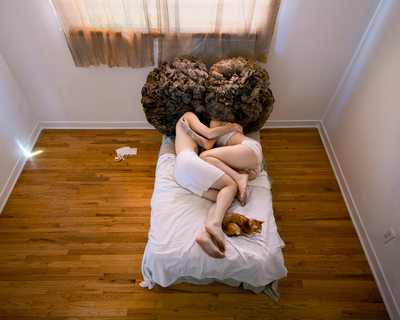
Soulmates, From the series Testament, 16”x20”, Pigment Ink on Fiber Rag, 2014
In this photograph, the sculpture you see was created from two churro sheep fleeces, one male and one female. The fleeces were freshly shorn, and were very heavy with dirt, detritus, and lanolin. To create the spherical shape, I wet the fleeces with warm water, and manipulated them using a process called wet felting. I agitated the fibers with my hands to tangle them together, rubbing the surface gently with water in a very gentle, repetitive motion. The result was two fleeces joined together with a tangled, web-like skin surrounding a mass of fleshy wool. In the Bible, followers are repeatedly referred to as sheep. For this image, I wanted to use wool in its most humble form, synonymous to the living animal itself.
Cancer, From the series Testament, 16”x20”, Pigment Ink on Fiber Rag, 2014
The red mass in this photograph was formed using dyed white Corriedale wool roving. The wool was shorn from the sheep, cleaned and stripped of its oils, then dyed with a heavy red pigment. This process is heavily symbolic, and references the sacrificial lamb. To create the shape, I used a process called needle felting, where wool fibers are tangled together in a precise manner using a tiny, spored needle. When I began to work with the material to create this mass, it began to take on a very tumor-like appearance, meriting the title, Cancer.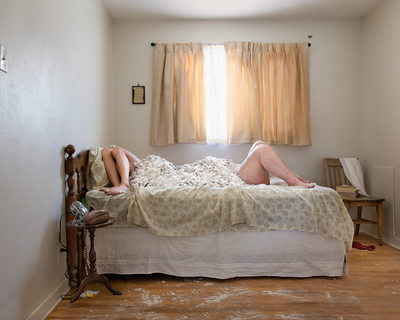
White Mass, From the series Testament, 16”x20”, Pigment Ink on Fiber Rag, 2014
For the white mass in this photograph, I formed hundreds of flat white discs from white porcelain clay, and dusted them in ashes. The forms resemble communion wafers, which point to the temporary human body, death, and resurrection. I was particularly interested in using clay as a material, to reference Isaiah 64:8 in the Bible: But now, O LORD, thou art our father; we are the clay, and thou our potter; and we all are the work of thy hand.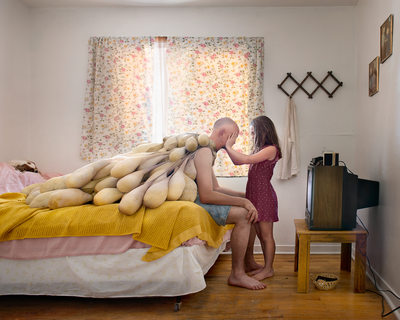
Father Daughter, From the series Testament, 16”x20”, Pigment Ink on Fiber Rag, 2014
The subjects in this photograph are my Pastor and his young daughter. The experience of making the image was enlightening for all of us, and truly enveloped the meaning of this work. The sculpture in this image was made using silk and white wool repeatedly dipped in beeswax. The forms were extremely heavy, and were physically exhausting to support. To create the image, each object was attached to the body one by one, creating a fragile, oppressive mass. The room felt very charged, and eerily still. Once the photograph was finally made and the weight was released, a true release was felt by everyone. It was a physical illustration of what it is to take on weight little by little, not realizing how heavy a burden has actually become. When that weight was lifted all at once, the sense of immediate relief was astonishing.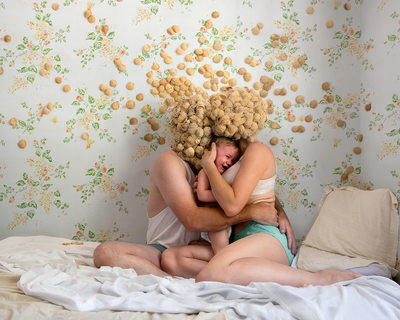
Little Baby, From the series Testament, 16”x20”, Pigment Ink on Fiber Rag, 2014
While experimenting with materials for this body of work, I learned to cast objects using latex rubber. I found that the material, when cast very thin, uncannily resembled my own skin. I created a variety of sculptures from cast rubber which resembled bodily forms such as cells, skin, muscle, and internal organs. To me, the casts for this image resemble infected cells, or viruses. For this sculpture, I cast hundreds of seed pods from a sycamore tree, and stitched them together to form masks for the subjects to wear.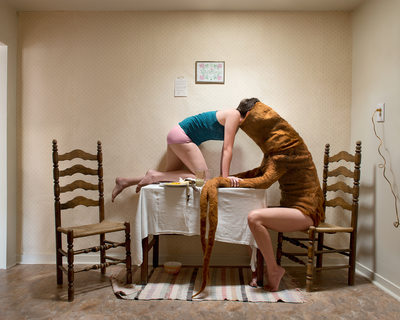
Fur Suit, From the series Testament, 16”x20”, Pigment Ink on Fiber Rag, 2014
The fur suit in this photograph is made from a garment I first patterned and sewed, and then covered in brown sheep’s wool. The wool is needle-felted inch by inch onto the surface of the garment. The suit renders the wearer quite vulnerable and dependent, much like the animal whose wool was used to fabricate it.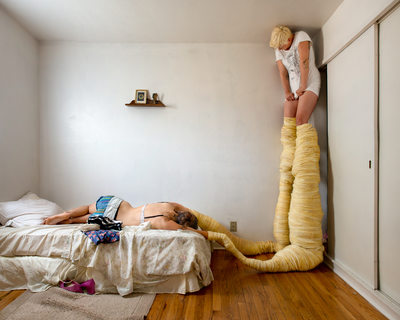
Inseparable, From the series Testament, 16”x20”, Pigment Ink on Fiber Rag, 2014
Much like the red cellular mass in Cancer, the sculpture in this photograph is made from dyed wool roving. I spun this roving loosely into yarn, and needle felted each piece to the next, slowly building soft organic shapes. The structures are fleshy and body-like, and appear to swell into a fatty growth. I found the gold color of the wool to be quite beautiful, rich and opulent-looking. Paired with the intestinal shape of the sculpture, it introduces curious analogy.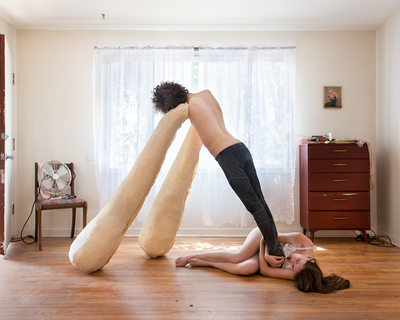
Rubber Arms, From the series Testament, 16”x20”, Pigment Ink on Fiber Rag, 2014
Like the tiny casts in Little Baby, the sculptures in this photograph are constructed with latex rubber. While experimenting with this material, I found that I could roll out a thin layer of liquid latex onto a cement floor with a paint roller. Once cured, this process created a fragile, life-like skin that could be peeled away from the floor and wrapped around a figure. The arm extensions in this photograph are two heavy plaster structures covered in delicate rubber skin. Their enormous weight completely immobilized the wearer, pointing to emotional exhaustion and absolute dependence.
Cocoon, From the series Testament, 16”x20”, Pigment Ink on Fiber Rag, 2014
The couple in this photograph is tightly wrapped in a narrow cocoon of white Shetland wool. In this form, the wool very closely resembles the actual fleece of the animal. Combined with human subjects, the form resembles a two-headed sheep. Such an animal, already meek and virtually helpless, is constantly pulling in opposite directions, continually fighting its own will.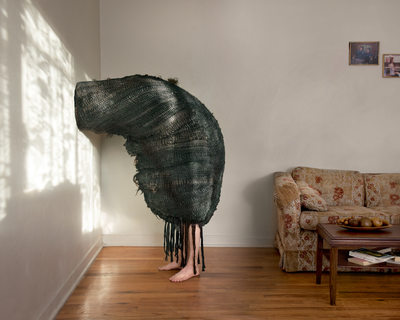
Hair Cloak, From the series Testament, 16”x20”, Pigment Ink on Fiber Rag, 2014
The cloak for this image was hand woven on a floor loom. I used black wool for the warp threads, and human hair for the weft. I love the idea of human DNA woven together with that of sheep, echoing the reference to human beings as sheep in various Biblical passages. I’m especially interested in this reference, particularly because of the meekness, dependence, and vulnerability of sheep, and their relationship to the human experience.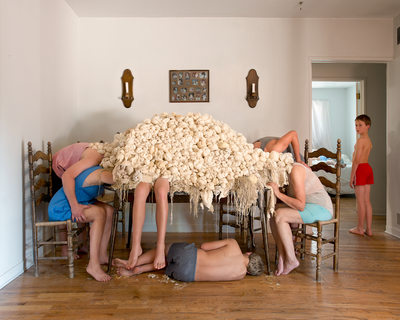
Family Portrait, From the series Testament, 16”x20”, Pigment Ink on Fiber Rag, 2014
The subjects in this photograph are members of my extended family. Photographing them was particularly meaningful, especially because I am privileged to knowledge of their personal hardships, and to their closeness as a family. To create the sculpture, I made latex casts of beautiful fresh fruits and vegetables, like those I imagine in the Garden of Eden. The result was a heap of delicate, flawed, flesh-like renderings of colorful, nourishing food. It creates a picture of human flaw, limitation, and blindness. It also illustrates like-mindedness and unconditional love.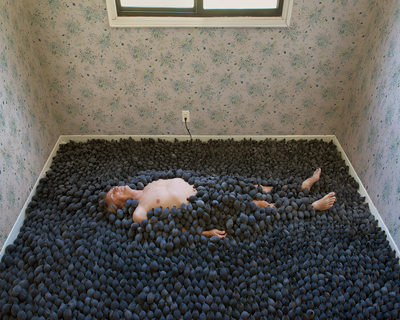
Burial, From the series Testament, 16”x20”, Pigment Ink on Fiber Rag, 2014
For this photograph, I covered the floor with hundreds of modified black latex balloons, filled and coated with dirt and ashes. The forms seem quite life-like, even bird-like, and are both beautiful and haunting. The objects echo the blue flowers in the wallpaper, and point to the cycle of life, impermanence, and mortality.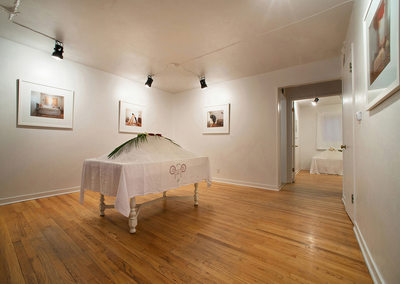
The family room included four photographs and a white dining table. The table was rescued, re-finished, and painted. It is covered with a white linen cloth, resembling ceremonial garments, or burial cloth. The cloth, hand-embroiderd by my Mother, exhibits a two-headed sheep, illustrating confusion, obstinance, and futility. The sheep carries a fetus in its shared uterus, denoting my personal struggle with infertility during the time I created this work. The table is covered in a mound of salt, pointing to the Sermon on the Mount, and Jesus’ reference to Christians as the Salt of the Earth.

Crowning the pile of salt on the dining table is a halved pomegranate, two stems of lily of the valley, two fresh gardenias, and two palm branches. In the Bible, pomegranates are symbols of righteousness. Shortly before his crucifixion, palm branches were waved at the triumphal entry of Jesus into Jerusalem. The act was adopted into Christian iconography to represent the victory of martyrs, or the victory of the spirit over the flesh. Lily of the Valley is a repeated Biblical symbol, and refers to the purity and beauty of Christ. I used fresh gardenias for their pungent aroma and their fragility. Their scent lasts only days, and their petals whither and bruise, representing the transitory, delicate human life.
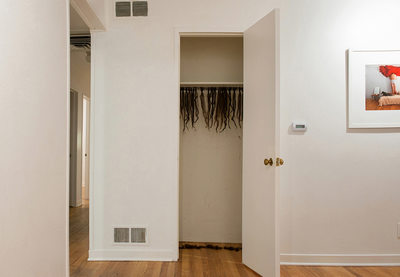
In the family room closet, strands of human hair hang on the clothing rod. This references the famous story of Samson and Delilah, and Samson’s loss of strength at the cutting of his long hair. I am also interested in human hair as a material because of its identifying qualities, and its concentration of DNA. It is physical evidence of the life of an individual, and remains intact and uncompromised long after death. On the floor of the closet are the freshly cut tips of each strand of hair.
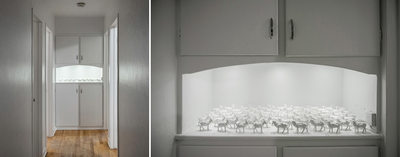
At the end of the main hallway is an obsolete telephone shelf, displaying an installation of miniature goats and sheep. On the left are 33 goats, and on the right, 33 sheep. In the Bible, the number 33 is repeatedly connected to the promises of God, and it is the age of Jesus at the time of crucifixion. The installation illustrates the parable of the sheep and the goats, found in the New Testament of the Bible. “All the nations will be gathered before Him; and He will separate them from one another, as the shepherd separates the sheep from the goats; and He will put the sheep on His right, and the goats on the left.”
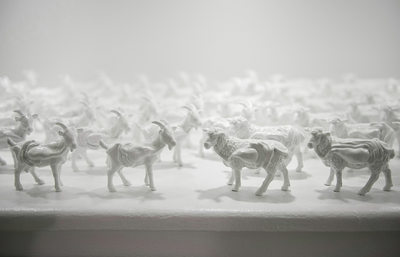
This image is a close-up of the installation of white resin goats and sheep, which occupied the telephone shelf at the end of the main hallway. Each figure displays a stomach and intestines outside it’s body, each formed from taxidermy clay and coated in white resin. The stomach and intestines resemble that of a human rather than the animal, illustrating the Biblical reference to human beings as goats and sheep, particularly in Jesus’ parable found in the book of Matthew. Historically, sheep and goats are frequently herded together. Sheep are docile, gentle creatures, whereas goats are unruly and can easily upset the sheep. Because they do not feed or rest well together, the shepherd often separates them for grazing and for sleeping at night. In the parable, Jesus states He will put the sheep on Hisright, the place of favor and blessing. The goats He will put on the left, the place of disfavor and rejection. For me, this installation represents human nature, our blindness, impressionability, and vulnerability.
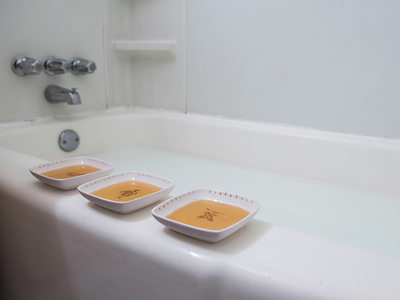
In the bathroom, the bathtub was filled with white milk. On it’s front edge were three small ceramic dishes filled with honey. This references the land of milk and honey depicted in the Song of Solomon, representing abundance, fertility, and delight. This land is referred to in Exodus as the promised land, flowing with sweetness, and free from slavery. In the center of each dish, I painted small figures of a rabbit, a speared sheep, and two fish, symbolizing abundance and fertility, sacrifice, and generosity. These materials were purposefully installed in the bathroom of the home, providing a stark contrast between the divine and the human, and illustrating human limitation and failure.
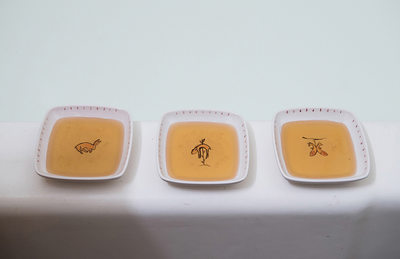
In the bathroom, the bathtub was filled with white milk. On it’s front edge were three small ceramic dishes filled with honey. This references the land of milk and honey depicted in the Song of Solomon, representing abundance, fertility, and delight. This land is referred to in Exodus as the promised land, flowing with sweetness, and free from slavery. In the center of each dish, I painted small figures of a rabbit, a speared sheep, and two fish, symbolizing abundance and fertility, sacrifice, and generosity. These materials were purposefully installed in the bathroom of the home, providing a stark contrast between the divine and the human, and illustrating human limitation and failure.
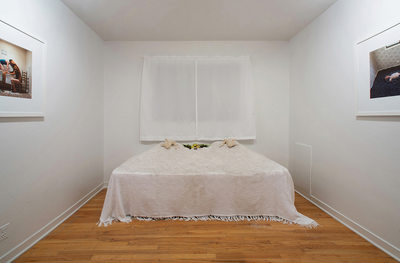
The master bedroom contained two photographs paired with a twin bed dressed in a white woven coverlet, covered in a heavy mound of white ashes. On the crest of the pile of ashes lay two cast rubber pigs, three pears, sprigs of lily of the valley, and dried figs. Biblically, pigs represent human disgrace and failure. Swine are regarded as the most unclean and abhorred of all animals. In the book of Matthew, a host of Demons are cast into a herd of pigs, who fling themselves into a body of water and drown. Together with the ashes, the pigs represent decay, and the passing of human life. The white coverlet is a vintage piece, dating to the 1950’s, and is roughly the same age as the house. It is worn and well-loved, and I imagined it to be wrought with the physical DNA of it’s owners, and full of their memory.
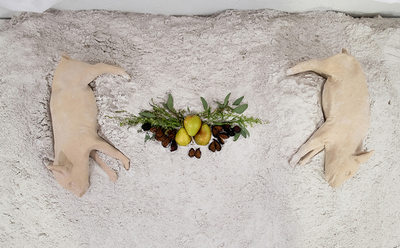
In this installation, two rubber pigs lay on a mass of white ashes. To create the sculptures of each pig, I painted liquid rubber onto a plastic mold to form a skin. Once cured, I carefully pulled the rubber skin from the mold and inverted it, creating a fleshy, hollow, soft form that draped delicately over the ashes. They looked like weak, vacant bodies, and paired with the ashes, represent the passing of human life.
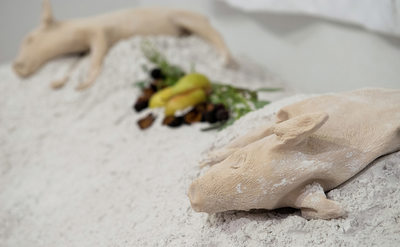
In this installation, a great mass of white ashes lay on top of a twin bed. Just before making this work, I took a course in Pueblo Pottery. When making clay vessels, if the author finds the pot too weak and soft, volcanic ash may be added to strengthen the walls, and make the pot viable. While the ashes represent death and passing, they also represent human strength and resolve. The three fresh pears symbolize the Holy Trinity. Lily of the Valley represents the purity of Christ, and the figs, the goodness and sweetness of each individual human life.
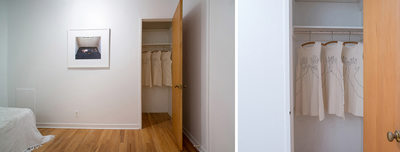
In the master bedroom closet hung three white linen tunics. Each was embroidered by my Mother, who I am very close to. Each garment exhibits the gesture of human hands during the act of prayer.
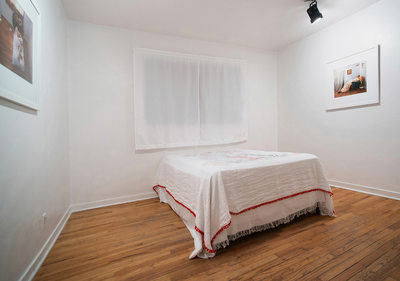
The smallest bedroom in the back of the house contained a full-sized bed covered in a white linen cloth. The linen itself is symbolic. It illustrates purity, and is often the mark of luxury in the Bible. The cloth was hand embroidered by my mother and one of our closest family friends. It features two human figures holding hands and grasping a shared heart, a design I created to represent the relationship between my husband and I. The cloth is lined in red cotton poms, which resemble blood cells, and contrast the clean, un-blemished white cloth.
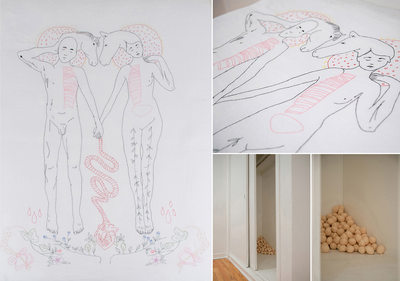
In this image, you see the full design that is embroidered onto the bedspread that covered the bed in the back bedroom of the house. The two figures are both haloed, referencing traditional religious art, and mimicking the shape that engrosses the heads of the two figures in the photograph Soulmates. Both the photograph and the linen spread represent the love relationship between my husband and I. On our wedding day, the last photograph taken was of Greg and I sitting together on the bed in our honeymoon suite, wearing our wedding garments and large, ridiculous latex horse masks. It is one of my favorite pictures of us together, because it shows our sense of humor, and how much we truly enjoy one another. The horse figures in this piece represent the joy, and the like-mindedness we share. The floral adornments reflect our fragrant garden wedding. The braids at the figures’ feet represent a cord of three strands. Ecclesiastes 4:12 reads, “And if one prevail against him, two shall withstand him; and a threefold cord is not quickly broken.”
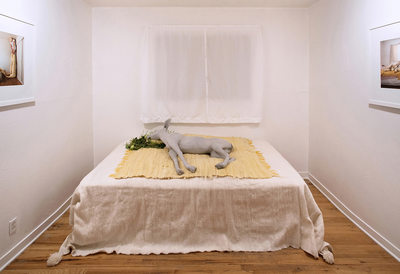
During the time I was working on the photographs for Testament, my close friend Rebecca reminded me of a passage in the book of Job. God is speaking to Job, and reminds him of his ultimate power and omnicience. He describes a deer who labors and brings forth her young, that He has counted the months until that birth, that He knows the very time, and watches as the fawn is born. This verse brings me great comfort, and reminds me of the great orchestration that is at work, and the significance of my small part in it. I sculpted the deer using a flat, grey taxidermy clay, and paired the figure with vibrant green apples picked from our apple tree, representing the transition from life to death, and the preciousness of every creature who walks the earth.
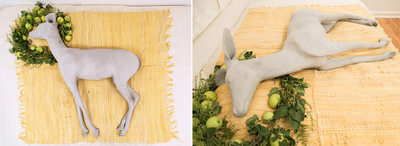
This installation occupied the front bedroom of the house. It is reminiscent of an altar, and conjures up images of animal sacrifice in the Old Testament of the Bible. The deer, constructed from grey taxidermy clay, appears ghost-like, almost like a void, or negative. In person, the room was very charged and eerily silent. Standing over the sculpture was almost like standing near the casket at a wake. Paired with fresh apples, the deer lay on a yellow blanket I wove using the gold wool roving that was used to fabricate the sculpture for the photograph, Inseparable, which hung in the room to the left of the bed. It is important for me to re-purpose and recycle material, as the act symbolizes redemption and deliverance. Under the gold blanket is a large woven spread with tassels, made from white Shetland wool.
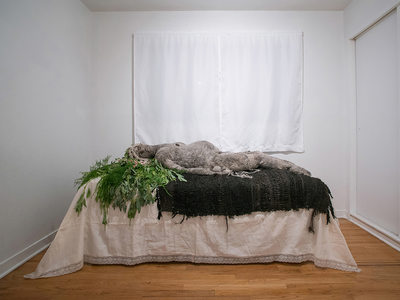
Occupying the smallest bedroom was a twin-sized bed covered in creamy white linen lined with antique lace. On the bed lay a sculpture of a pregnant woman fabricated entirely from grey churro wool. To create her, I re-purposed the two wool fleeces you see on the heads of the subjects in the photograph Soulmates. I cleaned the wool of lanolin and detritus by soaking it in several warm water baths. I dried the wool, combed, and carded it, creating a soft-bodied wool roving. I then slowly built up the body of the woman, using a wet felting technique for larger masses, and needle felting technique for detail areas. She is lying on a black woven blanket made from black wool yarn and human hair, which is re-purposed from the garment you see in the photograph Hair Cloak. I cut the cloak apart and re-assembled it, creating a rectangular shape for a bed covering.
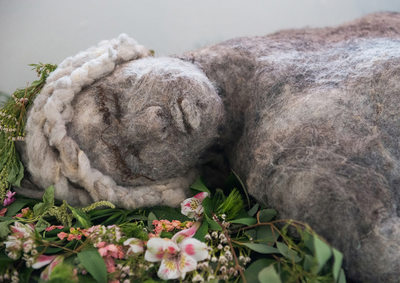
Here, you see a detail image of the face of the pregnant woman occupying the bed in the small bedroom of the house. She is made from two gray churro wool fleeces, and detailed with brown embroidery floss. Surrounding her head was a wreath made from pink lilies, lily of the valley, ferns, and fresh greens. The lilies echo those used in the front room of the house, and symbolize the purity of Christ. The vibrant pinks and greens contrast the grey tone of the body, and create a relationship between life and death. The installation is altar-like. In person, the figure of the woman was eerily life-like, as she was full-scale, and very expressive.

In each hand, the pregnant woman holds a fetus attached to an umbilical cord. Each fetus was created by needle-felting grey churro wool. During the time I was working on Testament, my husband and I were struggling with infertility, and were struggling to conceive our first baby. This sculpture is an illustration of that battle, and the spiritual struggle that accompanied it. Testament was first exhibited in October of 2014. In February of 2015, we were overjoyed to learn of the conception of our baby boy, who was born the following November.
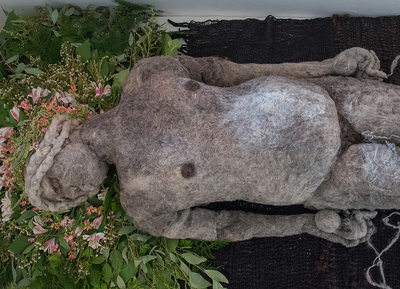
Here, you see an over-head image of the sculpture of a pregnant woman and her two fetuses. She is fabricated wholly from grey churro sheep’s wool which I washed, carded, combed, and manipulated. I created her form by wet felting the wool in larger areas, and needle felting in detail areas such as her face, hair, hands, and feet. Sheep’s wool is used throughout this body of work as a symbol of the human spiritual experience, and as an illustration of our relationship to God.
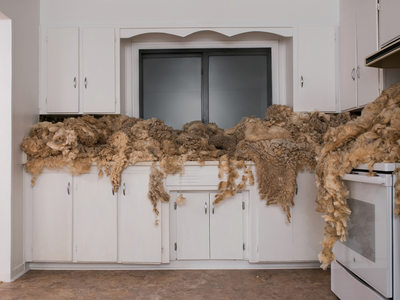
The kitchen of the house was adjacent to the main living room, and to the hallway leading to all four bedrooms. In this space, I covered the countertops, sink, and stove in freshly shorn white wool fleeces. The wool was heavy with lanolin, and fully soiled with dirt, feces, and detritus. The gold and brown hues of the wool exhibit its filthiness; once cleaned, the wool is creamy white in color. The room was extremely fragrant with the scent of animals, reminiscent of a stable. The dirty wool contrasts the bright white of the freshly painted cabinetry, and is an interesting pairing in a space such as a kitchen. It occupies surfaces where food is conventionally cleaned and prepared, in a part of a home that is generally kept most clean and sanitary. Throughout Testament, sheep’s wool is used as a symbol of the relationship between God and human kind, our limited earthly experience, and our vulnerability. This installation illustrates human failure, and the contrast between sinfulness and purity.
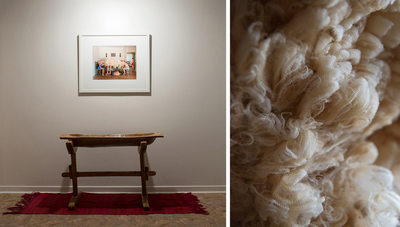
Opposite the kitchen cabinetry covered in wool fleeces stood a wooden animal trough filled with water. It is suggestive of the font of holy water at the entrance of a Catholic church. The animal trough pairs with the freshly shorn wool fleeces, and recalls the manger scene outlined in the Christian Christmas story. The trough stood on a red hand-woven rug. To weave it, I spun yarn from the red wool used in the large tumorous sculpture in the photograph Cancer. The act of re-purposing and re-vitalizing is a consistent theme through this body of work, and illustrates re-birth, renewal, and grace. The image on the right shows the beautiful crimps in the white wool that covered the surfaces of the kitchen.
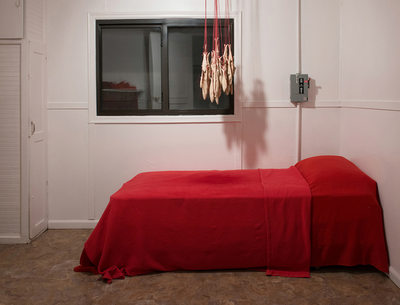
We called this space the mud room. It is adjacent to the kitchen through one doorway and the garage through another, and has a door leading to the back yard. Here, I installed a twin bed covered in a freshly dyed red blanket. Hovering over the bed is a sculpture of 33 cast rubber fish tied up with red wool yarn. To create them, I painted liquid latex over wooden fish molds and peeled the rubber off gently, inverting the shape and creating a hollow rubber form
The fish became a symbol for Christianity in the early days of the post-apostolic church and is still used today, particularly in the United States. The initial letters of each word in the Greek phrase "Jesus Christ, Son of God, Savior" form the word ICHTHUS, which means "fish." Fish are also present in several of Jesus’ most known miracles. In the Matthew 14, two fish and five loaves of bread are broken to feed a crowd of five thousand. In John 21, Jesus appears to His disciples who are fishing on the Sea of Galilee, and a miraculous hoard of fish are caught in their net. In Matthew 4:19 Jesus says “Come, follow Me, and I will make you fishers of men."
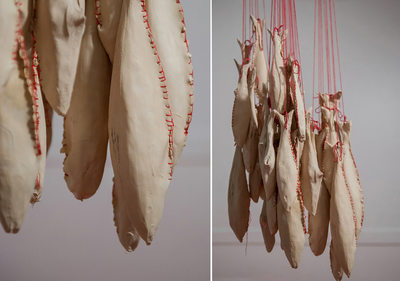
The fish became a symbol for Christians in the early days of the post-apostolic church and is still used today, particularly in the United States. The initial letters of each word in the Greek phrase "Jesus Christ, Son of God, Savior" form the word ICHTHUS, which means "fish." For the exhibition, each fish was filled with water, slowly dripping from a tiny puncture in the mouth of the fish. Biblically, water is used in the sacrament of Baptism, and represents purity and transformation. The water created a dark spot on the red cloth below, reminiscent of menstrual blood, or blood following a birth. The installation is a picture of clear water turned to blood stain, blamelessness turned to blemish.
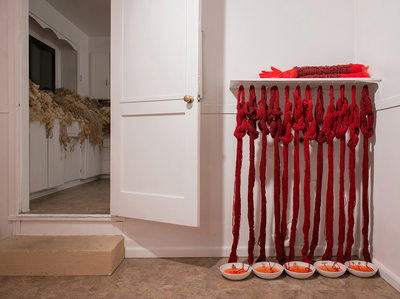
This installation occupied the mud room, and shared a space with the installation of rubber fish. Twelve warping chains of red wool yarn hung below a storage shelf, signifying the number of twelve disciples. Each chain was wound on a warping board, a step taken in preparation for warping a loom for weaving. The method orders the yarn and prevents it from becoming tangled or damaged in the process of installation on the loom. When learning to weave, I always found the process of winding a warp to be quite meditative, and the chain itself to be very beautiful.
The red chains are body-like, reminiscent of muscle fiber or veins. The ends of each warping chain rested in shallow bowls of water. Over the course of the evening, the water became progressively stained with the red pigment that had not yet been washed from the dyed yarn. The installation echos the meaning of the installation of fish, depicting a bloody stain, and illustrating the progression from innocence to iniquity.
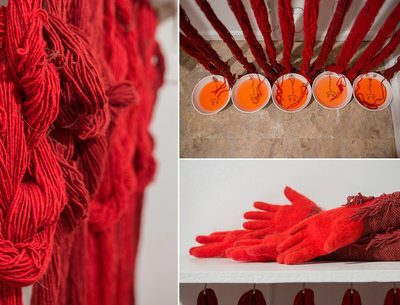
This installation occupied the mud room of the house, adjacent to the kitchen, the back door, and the garage, displayed across the room from the installation of rubber fish. Twelve chains of red wool yarn hung beneath a shelf, and bled red pigment into six shallow bowls of water. I hand-painted each bowl with images of human organs connected to pigs through a leafy vine, an illustration of humanness, spiritual deficiency, and limitation. Installed above the warping chains were two pair of hands formed from the red wool you see in the tumorous sculpture in the photograph, Cancer. The process of reuse and repurpose is important in my work, and illustrates recovery and redemption. Each arm is covered in cloth I wove on my hand loom using red wool yarn. The selvedge of these weavings is left un-tied, resembling the flesh beneath the skin, the parts of that remain hidden and undisclosed. Our hands and our fingerprints, mark us as individuals. Their function elevate us beyond other creatures on the earth, and are responsible for a remarkable part of the human experience. In this installation, the hands simply represent the human body, and the significance of every unique individual. The two pair of hands represent two people as partners, and echo the relationships in many of the photographic works.

The premier exhibition of Testament took place in the house in which the photographs were created. The house was cleaned, polished, and freshly painted. Holes and scars were patched and mended, and the house was shown at it’s very best. This was a picture of redemption and restoration, a theme that is at the root of my work. The exhibition included 12 photographs paired with sculptures, installations, and textile works. Each object or textile borrows Biblical language and symbolism, and references specific moments of understanding and awareness in my personal spiritual journey.
If you look carefully, you will see each stage of a sheep’s wool, and its evolution from the animal’s fleece to finished woven cloth. Wool is shorn, picked, washed, carded, spun into yarn, dyed, and finally woven into a functional woven or felted textile. Many of the materials used to make sculptures for the photographs were re-used and re-purposed to create new objects for the exhibition, illustrating themes of renewal and rebirth.
In her collection, Testament, Jennifer B. Thoreson’s staged photography and installations illustrate a complex range of human interactions, experiences, and relationships. Each scene is portrayed within a series of spaces, alongside an assemblage of sculptures and objects, that bear witness to the lives she represents. In this series of work, she investigates “the spiritual labor of bearing weight, submission, futility, and persistence.” The collection is a testament to the heavy burdens of life – physical, emotional, and spiritual – and to the resilience of humanity and our most foundational connections – those of family, lovers, and friends. The installed exhibition echoes the themes of the photographs, and uses a material language connected to the bible to tell a story of sacrifice, promise, and transformation. In each photograph, the audience sees a moment of connection or solitude in which Thoreson invests a piece of herself, telling some aspect of her own childhood, memory, faith, and spirituality. By creating a work that is so rich and personal, she allows the viewer to connect personally to the narratives she tells.
In the photograph, “Cancer,” Thoreson captures a man and woman in a bedroom, flanked by two dogs. The bedroom is sparsely furnished with a bed in the corner, a chair at its foot, and several quotidian objects in the scene. The man stands on the bed facing the wall and is engulfed by a deep red organic mass emanating from his head. The woman, also facing the wall, appears to be sleeping. The two are in physical contact, connected at their legs. We wonder where in this image does the cancer lie? Is it the red mass, growing out of the man in an outwardly visible way? Or, does the man have cancer within his body, and the emanating red is a visible sign that he feels trapped, unable to see out, as the woman lays by his side? Does the woman have cancer, and the red is a sign of the grief and fear experienced by the man for the one he loves, a physical burden for him to carry? The depth of the work leaves space for any of these possibilities and more. Thoreson allows the meaning of her photographs to be arrived at individually, to depend upon the experiences of the viewer.
Throughout the collection, Thoreson explores the intricacies of many types of relationships. In “Father Daughter,” the father figure, heavy-laden with the pilings of a bulbous shell that seems to cripple him, pulling him towards the bed, is tenderly confronted by his daughter. Thoreson inverts the assumed relationship of parent and child, and shows the young girl caring for her father, encouraging him as he feels and bears the great burdens of his life. In “Inseparable,” two women – perhaps friends, sisters, or partners – are inexorably joined together. With shackled limbs, one reaches out while the other pulls away. Thoreson captures an irony, an unevenness, at times a suffocation that can exist in an “inseparable” relationship. She creates the same complexity, vulnerability, and emotion in each of her photographs as she expertly captures cares and burdens that are widely experienced but in incredibly personal, individualized ways.